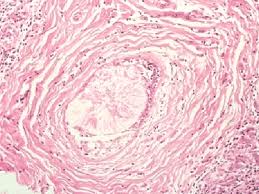Calymmian Period
 The Calymmian Period
The Calymmian Period
Stenian Period
 The Stenian Period
The Stenian Period
Ectasian Period
 The Ectasian Period
The Ectasian Period
Mesoproterozoic Era
Mesoproterozoic Era is the era of excellent geological records. It Began from 1.6 billion to 1.0 billion years ago and lasted nearly 600 million years. Major development of continental plate tectonics and plates are characteristics from the Mesoproterozoic Era. The continental plates developed near the end of this era have undergone little or no changes in further eras.
Major highlights of the Mesoproterozoic Era
- Rodinia, the first super continent appeared in this era
- The Grenville Orogeny was also built in this era. It is considered as the 1st large-scale mountain building phase. Evidence of this building episode still survive today
- The stromatolites reached their highest points in this era
- This is the era of sexual reproduction and communal development among the organisms, particularly in the multicellular species
- Atmospheric oxygen began to rise and hold steadily about 1% until photosynthesis developed
- In this era there are significant changes occur in the chemistry of ocean
Mesoproterozoic Era: Its divisions
Division of the mesoproterozoic era is really interesting. It is equally divided into 3 periods, each with a time span of 200 million year. It is chronometrically arranged. There are 3 major periods of Mesoproterozoic Era - Calymmian, Ectasian, and Stenian. Each of these periods have individual features and contributed to the development of the era.
Mesoproterozoic Era: The Calymmian period
The name of this period denotes the features of this period. According to the Greek meaning the name stands for ‘cover’ and is highly symbolical of the platform covers over cratons. There were major development and expansions of layers of deposits which accumulated over the earth’s cratons in this period. Hence the name is of this period is Calymmian.
This development and expansion of layers is the part of a continental building process where crust of the Earth thickens as rocks deposits on the peak of older rocks. Expansions of continental plates are due to deposition of sediments along the coast of the seas as they are washed into the oceans. This made the sea much more shallow, giving place to the continental plates to develop. Formation of new land was also due to continental movements making seas shallower between the landmasses.
Breaking of Columbia in the Calymmian period
It was the Calymmian period when Columbia, the first continent suffered from major breakups. It started about 1.6 billion years ago and this division of the first continent continued until the Ectasian period. During this process of major rifting it had taken place along Laurentia’s western margin, India’s eastern margin, Baltica’s southern margin, Siberia’s southeastern margin, South Africa’s northwestern margin, and block of South China’s northern margin. Volcanic activities accompanied the rifting and opened places for the formation of huge igneous rocks in the regions.
Mesoproterozoic Era: The Ectasian Period
This lasted from 1.4 billion to 1.2 billion years and this period is the phase of platform extensions. It is the second period of the era and contributed in the expansion of continental landmasses. Drifting of continents continued with the drifting process till the mid of Ectasian period.
It is in this period that the first evidence of sexual reproduction was discovered. The age-old Somerset Isle’s, old Hunting Formation in north Canada dated back to the Ectasian period. Multicellular filaments’ microfossils had been discovered which was known as of Bangiomorpha pubescens. This was a kind of red algae.
This red algae, Bangiomorpha pubescens were thought to be the first organisms to exhibit sexual reproduction. This is also one of the complex but essential features of multicellularity.
Complex multicellularity and simple multicellularity
Complex multicellularity differs from simple multicellularity when organisms live together in colonies. Cells of true multicellular organisms have a specialization to perform different functions. Sexual reproduction is one of those essential functions where the gametes of female and male organisms are the specialized cells.
Mesoproterozoic Era: The Stenian period
This is the last of the 3 periods of the Mesoproterozoic era. This period lasted from 1.2 billion to 1.0 billion years ago and several major continental developments of the era took place in this period. Rodina, the first super continent, appeared in this period. The name of the super continent Rodinia refers to the development of the formation of the narrow polymetamorphic belts. Formation of Rodinia is interesting and its evidences still survive. The event which gave rise to this supercontinent was known as Grenville Orogeny and in the mountain ranges of North America and Western Europe, the evidence exists today.
How Rodinia was at that time?
Rodinia was thought to be a desolate and stark place with a less trace of life. Life only existed in the form of stromatolites which grew profusely along the coastlines. It was also assumed that vast floodplain occupied the center of the continent containing old deposits of sediments and silts. It was not obstructed and the continents had suffered from massive floods. A massive sedimentary rock basin, the belt supergroup, extended across Washington, Idaho, Montana, British Columbia, and Alberta. All of these were full of limestone, siltstone, and sandstone They preserved beautifully with the features of stromatolites, ripples, and cracks.
It was also assumed that the super continent, Rodinia was not full of land and was surrounded by an ocean called Mirovia. There must be several inland seas and rivers where stromatolites grew in abundance. The belt near the line of Washington, Idaho reached as high as 50,000 feet with thick stromatolites.
The first super continent was also known to be responsible for producing some major changes in the Earth. It was the only landmass which existed up until the Mesoproterozoic Era. This was highly responsible for changing ocean currents which were thought to form snowball Earth in the Cryogenian period.
It is really interesting to know the Earth in its ancient days. It is equally exciting to know that our present day Earth is completely different from its ancient type and it takes the present form through process of evolution. Facts about the beginning of Life, formation of continents, mountains, rivers, seas, diverse species all are really fascinating.

Index
Extinct Profiles
 Triassic Dinosaurs
Triassic Dinosaurs Jurassic Dinosaurs
Jurassic Dinosaurs Cretaceous Dinosaurs
Cretaceous Dinosaurs Pterosaurs
Pterosaurs Marine Reptiles
Marine Reptiles Dinosaur Extinction
Dinosaur Extinction